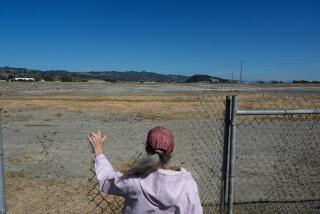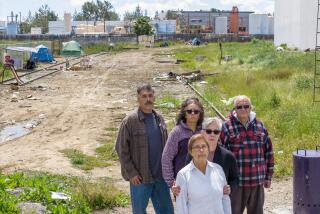‘Belching’ Caldron Is No. 1 Nuclear Waste Problem
- Share via
RICHLAND, Wash. — Energy Secretary James D. Watkins has called it “the No. 1 safety issue” in the Energy Department’s 12-state network of nuclear bomb factories.
Officially, it is Tank 101-SY. Here at the department’s Hanford site, it is called “the burping tank” or simply “the tank,” the one with lightning arresters installed to prevent a spark from touching it off.
Tank 101-SY is a million-gallon, underground caldron of radioactive sludge and toxic solvents and who-knows-what-else, seething and brewing beneath a semisolid crust that has formed atop the liquid. Every 100 days or so, the tank emits a huge belch as hydrogen building up on the bottom bursts through the crust to be vented through filters into the atmosphere.
The burping tank is the most famous, or rather the most notorious, of the 177 tanks of mixed radioactive wastes buried in 18 “tank farms” at Hanford. The wastes are potentially lethal byproducts from Hanford’s 45 years as a plutonium factory. The facility’s chemical processing lines dissolved irradiated uranium fuel in acids to extract the building blocks of nuclear warheads.
Many of the tanks leak and in at least one, the contents have boiled. The tanks present a massive waste management and disposal problem for which there is no definite solution. Of all the tanks, none is the focus of more concern than 101-SY, mostly because scientists have not yet figured out exactly what it contains.
“This is a most serious and urgent problem,” said tank farm manager Ronald Gerton. “The worst thing that could happen is that the gases would ignite” and blow out filters containing trapped radioactive material. A year ago, he said, officials feared that an explosion in 101-SY would ignite other tanks nearby and cause a mammoth explosion that could threaten neighboring cities. “Now we know there is not enough energy in there to blow it out,” Gerton said. “It shouldn’t be an off-site concern.”
Other scientists dispute that conclusion. They say that any spark could touch off a radioactive holocaust that would rival history’s worst nuclear accidents.
In May, 1990, Watkins ordered several measures aimed at reducing the tank’s threat. He said that “while the probability of hydrogen combustion is believed to be low, in the event of an explosion, the potential may exist for a fire and secondary pressure . . . from the combustion of nitrate compounds.”
In July, 1990, an internal Energy Department study found the only reason to believe that an explosion was unlikely was that none had taken place. The report said the Energy Department and its contractors at Hanford had known for 13 years that 101-SY was generating volatile gases, but they “failed to exercise appropriate safety oversight.”
More to Read
Sign up for Essential California
The most important California stories and recommendations in your inbox every morning.
You may occasionally receive promotional content from the Los Angeles Times.










